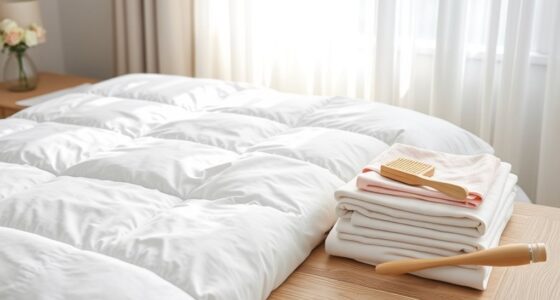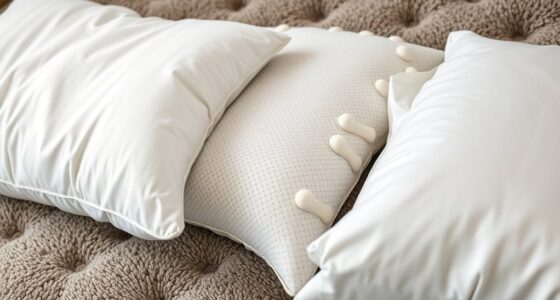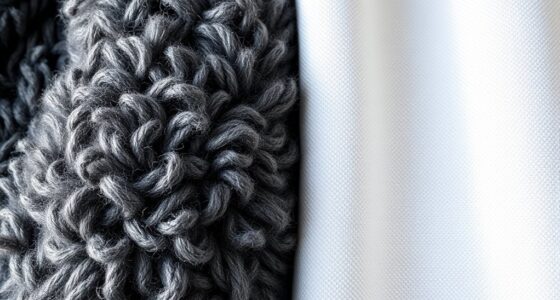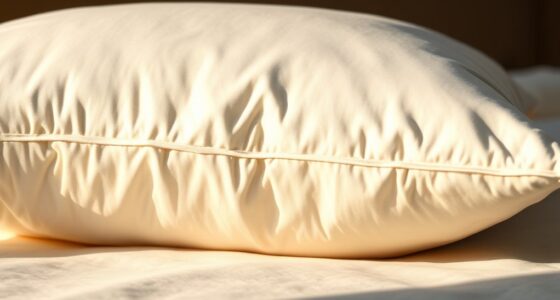Choosing the right comforter fill depends on your priorities. Down offers excellent warmth and lightweight comfort, perfect for cold climates but needs careful care and may trigger allergies. Down alternatives are hypoallergenic, easy to maintain, and resist dust mites, making them great for allergy sufferers. Wool fills are naturally hypoallergenic, moisture-wicking, and durable, providing long-lasting comfort. Each option has unique benefits; exploring these can help you find the perfect fit for your needs.
Key Takeaways
- Down fills offer high warmth, lightweight comfort, and durability but may require special care and are not inherently hypoallergenic.
- Down alternative fills are synthetic, hypoallergenic, easy to clean, and resistant to dust mites and mold.
- Wool fills provide natural hypoallergenic properties, moisture-wicking, and long-lasting insulation with low maintenance.
- Material durability varies; high-quality fills retain loft and warmth longer, especially with proper washing and care.
- Choice of fill depends on priorities like warmth, allergy sensitivity, ease of maintenance, and natural versus synthetic preferences.
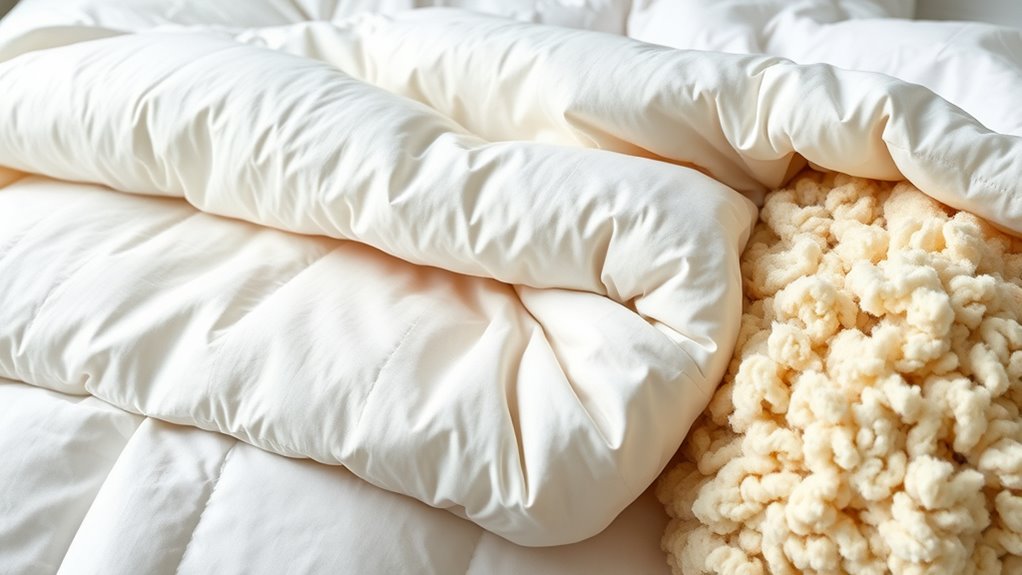
Ever wondered what makes a comforter cozy and warm? It all starts with the fill type, which plays a vital role in how it feels and performs. When choosing a comforter, you’ll want to consider material durability—how well it holds up over time—and hypoallergenic options, especially if you have allergies or sensitive skin. These factors help guarantee your comforter remains soft, supportive, and safe for years to come.
Down fills, often sourced from ducks or geese, are popular because they offer excellent insulation and a lightweight feel. They tend to be very durable if properly cared for, meaning your comforter can last many seasons. However, down isn’t inherently hypoallergenic. If you’re sensitive or allergic, you’ll need to look for down comforters that are specially treated or opt for hypoallergenic alternatives. These alternatives mimic the fluffy warmth of down but are made from synthetic fibers, offering better material durability and allergy protection. Plus, they’re easier to maintain and often more resistant to dust mites and mold.
Down alternative fills are a versatile option if you want something hypoallergenic, easier to clean, and with consistent material durability. They typically use polyester or microfiber, which are resistant to shrinking, clumping, and dust mites, making them ideal for allergy sufferers. These synthetic fills also tend to be more affordable and maintain their loft longer with proper care, providing lasting warmth without sacrificing comfort. If you prefer natural materials, wool fills might catch your eye. Wool is naturally hypoallergenic, moisture-wicking, and resistant to mold and dust mites. It’s also incredibly durable and can regulate temperature effectively, keeping you warm in winter and cool in summer. Wool-filled comforters tend to be long-lasting, and their natural fibers resist compression, maintaining loft over time.
Additionally, some comforters incorporate specialized insulation materials to enhance warmth and breathability. Ultimately, your choice depends on your priorities—whether you want the lightweight luxury of down, the allergy-friendly qualities of synthetic fills, or the natural benefits of wool. Consider how each material handles regular washing and care, as this impacts long-term durability. If longevity is important, look for high-quality fills that retain their loft and insulating properties through many washes. For allergy concerns, hypoallergenic options like synthetic or wool fills are your best bet. No matter which you pick, understanding the strengths of each fill type helps you find a comforter that keeps you cozy, supports your health, and lasts through the seasons.
Frequently Asked Questions
Which Comforter Fill Type Is Best for Allergy Sufferers?
If you’re allergy sufferers, you want a comforter with hypoallergenic benefits that reduce allergic reactions. You should look for materials designed to minimize dust mites and allergens, especially if you have material sensitivities. Hypoallergenic options like synthetic fills or wool offer better protection against allergens, helping you sleep peacefully. Choosing the right fill type guarantees comfort and health, making it easier to enjoy restful nights without worry about allergy flare-ups.
How Do I Properly Care for and Clean Different Comforter Fills?
To care for and clean your comforter properly, follow the care instructions on the label. Regularly shake and air it out to maintain freshness. For cleaning, use gentle cycles with mild detergent, and check if it’s machine washable or needs professional cleaning. For different fill types, adjust your cleaning tips accordingly—down and wool may need special care, while down alternative is often easier to wash at home.
Are There Eco-Friendly or Sustainable Comforter Fill Options?
You’d think finding an eco-friendly comforter is a breeze, right? Turns out, it’s quite the quest! Luckily, options with organic fibers and eco-conscious manufacturing exist, letting you sleep soundly knowing you’re helping the planet. These comforters are made with sustainable materials like organic cotton, bamboo, or recycled fabrics. So, while you’re cozying up, you’re also supporting a healthier Earth—dreams do come true, after all!
How Does Fill Power Affect Comforter Warmth and Loft?
Fill power directly impacts your comforter‘s warmth and loft retention. Higher fill power means more insulating ability, so your comforter stays warmer and fluffier over time. It also indicates better loft retention, helping the comforter maintain its shape and cozy feel longer. When choosing a comforter, consider a higher fill power for added warmth and durability, ensuring you’re comfy and your comforter lasts through many cozy nights.
Can Different Fill Types Be Combined in One Comforter?
Imagine a quilt woven from different threads, each adding its unique strength—this is what hybrid comforters do with fill blending. Yes, you can combine different fill types in one comforter, creating a layered symphony of warmth and softness. Hybrid comforters offer the best of both worlds, balancing insulation, comfort, and durability. By blending fills like down and wool, you customize your sleep experience to match your climate and personal preference.
Conclusion
Now that you know the different comforter fill types, imagine wrapping yourself in a cloud of softness each night. Whether it’s the plush warmth of down, the cozy feel of wool, or the versatile touch of down alternative, your perfect sleep companion awaits. Choose what feels like a gentle hug, and drift into peaceful dreams wrapped in comfort. Your ideal night’s sleep is just a fill type away—ready to surround you with warmth and serenity.


